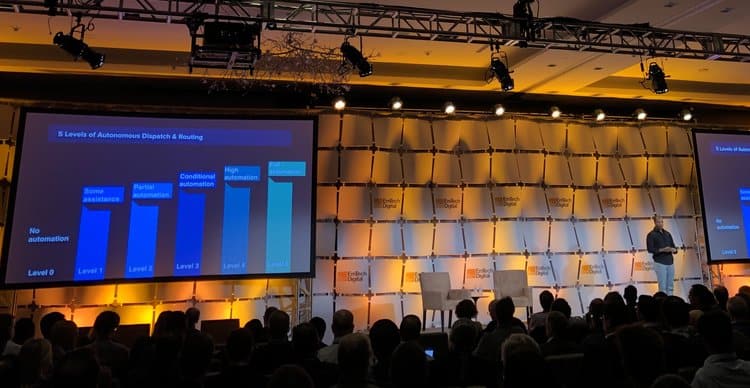
EmTech Digital 2019 | AI in Transportation

Wise Systems
EmTech Digital 2019 | AI in Transportation

Wise Systems

Recently, I had the pleasure of speaking at EmTech Digital 2019 , MIT Technology Review’s conference focused on various aspects of Artificial Intelligence (AI). In the course of the two-day program, industry leaders explored the state of AI, the human impact, ethical considerations, potential benefits, and applications to different industries, from healthcare and chemistry to transportation.
The Industry Impact: AI in Transportation section included perspectives from Dmitri Dolgov, CTO and VP of Engineering, Waymo, and Taniya Mishra, Director of AI Research and Lead Speech Scientist, Affectiva. Dimitri’s remarks focused on Getting Autonomous Cars Ready for the Road, while Taniya covered Redefining Human-Machine Partnership through Emotion AI, talking about the applications of emotion-sensing technologies in cars. For my session, I dove into AI in Logistics and Transportation. The challenge was to explain the importance of AI in logistics in a way that was relevant to a room full of seasoned professionals, most of whom are not from the logistics industry.

With a career spent at the intersection of logistics and technology, I see many opportunities for AI to transform all facets of transportation in cities and eliminate the issues that plague most urban centers today — traffic, congestion, delays and pollution. Re-shaping how cities operate starts with data-driven fleet logistics systems that use granular data and sophisticated algorithms, and expands to cross-fleet coordination, followed by city-wide systems.
With access to increasing amounts of high-quality data, AI can go beyond simple optimizations to predictions and prescribed behaviors that mitigate so many of the issues that compromise fleet performance. For example, when asked what they think drivers spend the majority of their time doing, most people estimate that it’s spent driving, either in traffic or traveling between stops. With our software, we know that the majority of drivers’ time is spent at customer sites parking, unloading, getting signatures, and other tasks. With the data to accurately show this time allocation, AI and machine learning maximize fleet utilization, optimize plans and improve overall performance. This very practical application of AI is part of our Autonomous Dispatch and Routing system, which has the potential to improve routing for individual fleets today, and cross-fleet coordination in the cities of the future.
Looking at the road ahead, we see the development of Autonomous Dispatch and Routing capabilities in direct parallel to autonomous vehicles (AVs). AVs are characterized from Level 0 to Level 5, where Level 0 refers most cars on the road today (no automation – not even adaptive cruise control), while Level 5 is a fully autonomous vehicle that can handle any scenario as well as or better than a human. In Autonomous Dispatch and Routing, Level 0 refers to operations teams that manually route their drivers, where Level 5 refers to fully automated dispatching and routing across any industry or scenario. Many of today’s fleets range between Level 0 and Level 2, and our goal at Wise Systems is to rapidly move the industry to Levels 3 and beyond.
In the months ahead, we’ll be talking more about the 5 Levels of Autonomous Dispatch and Routing, the characteristics of each stage, and vertical industry examples. In the meantime, if you’re interested in learning more about the EmTech Digital presentations about everything from ethics in AI to AI in life sciences, here’s the site. And, if you’d like to see my remarks, they’re here.





